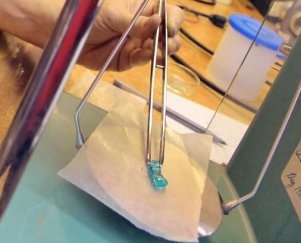An artificial muscle that can stick to metal electrodes and make space robots of the future more agile will be tested by NASA aboard the International Space Station (ISS).
The synthetic muscle was developed by polymer chemist Lenore Rasmussen from the US Department of Energy's Princeton Plasma Physics Lab (PPPL) and will be launched this week aboard an ISS re-supply mission.
It's believed that these synthetic muscles could enable the development of more dexterous robots for space exploration, which can better mimic the natural body movements of humans.
"We can't explore space without robots," Rasmussen said in a press release. "Humans can only withstand a certain amount of radiation so that limits the time that people can be in space, whereas robots, particularly if they're radiation-resistant, can be up there for long periods of time without being replaced."
In addition to robots, which can operate in challenging environments in space and on Earth, these artificial muscles could also lead to more advanced prosthetics, giving users more natural mobility.
Rasmussen first patented her synthetic muscle, which is made of a gel-like material known as an electroactive polymer, way back in 1998. This material can expand and contract like a human muscle.
The key ever since has been working out how to get her material to adhere to metal electrodes, which need to be implanted inside the gel in order to control its movements.
She was able to solve this problem by treating steel and titanium surfaces with a special plasma solution that was super-heated and electrically charged. This altered the surface chemistry of the metal and allowed the gel to bond more closely, continuing to adhere even after repeated muscle simulations.
Earth-based tests have already shown that the material can withstand extreme levels of radiation, far exceeding amounts considered lethal to humans. In 2014, researchers exposed the artificial muscle to 20 times the gamma radiation a human could survive, which they said was about the equivalent of a non-stop return trip from Earth to Mars.
A second test lasting 45 hours was enough to be equivalent to a trip to Jupiter and beyond, according to the PPPL press release.
While the material underwent a slight change of colour, researchers say its strength, electroactivity and durability didn't falter. Further tests revealed that it could hold up nicely against extreme temperatures close to absolute zero, or roughly minus 271 degrees Celsius.
"The next step is to see how it behaves in a space environment," said Charles Gentile, an engineer who worked on the technology. "From there the next step might be to use it on a mission to Mars."
The artificial muscle will be packaged aboard the SpaceX Dragon capsule, which will launch this week aboard a Falcon 9 rocket. Once in space, the capsule will be captured by the ISS crew.
The material will be kept in a zero gravity storage rack in the US National Laboratory on the ISS for 90 days, with astronauts snapping photograph of the synthetic muscle every three weeks. When it returns in July, it will be tested and compared with identical materials that remained on Earth. The objective is to test its radiation resistance in a space-based environment.
Hopefully they hold-up okay, even if we're a bit weary of robots that can move like humans.
